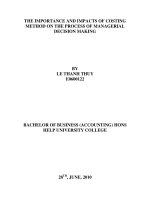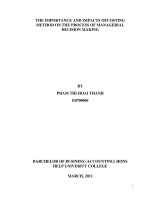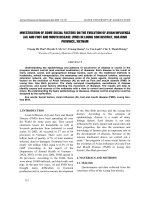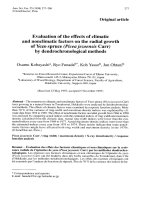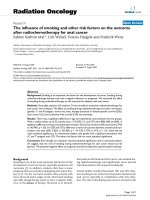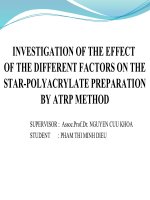effect of various factors on the process of yogurt product supplemented with soymilk
Bạn đang xem bản rút gọn của tài liệu. Xem và tải ngay bản đầy đủ của tài liệu tại đây (6.86 MB, 98 trang )
<span class="text_page_counter">Trang 1</span><div class="page_container" data-page="1">
MINISTRY OF EDUCATION AND TRAINING
<b>HO CHI MINH CITY UNIVERSITY OF TECHNOLOGY AND EDUCATION FACULTY FOR HIGH QUALITY TRAINING </b>
<b>LECTURER: DANG THI NGOC DUNG </b>
<b>STUDENT: NGUYEN VU DUC HOAI NGUYEN HUYNH GIA HUY</b>
<small>S K L 0 1 2 5 3 0 </small>
</div><span class="text_page_counter">Trang 2</span><div class="page_container" data-page="2"><b>EFFECT OF VARIOUS FACTORS ON THE PROCESS OF YOGURT PRODUCT </b>
<b>SUPPLEMENTED WITH SOYMILK</b>
</div><span class="text_page_counter">Trang 3</span><div class="page_container" data-page="3"><b>GRADUATION THESIS ASSIGNMENT </b>
Student name: Nguyễn Vũ Đức Hoài Student ID: 19116052
Student name: Nguyễn Huỳnh Gia Huy Student ID: 19116016
Supervisor: Đặng Thị Ngọc Dung M.Eng. Email: Date of assignment: 28/08/2023 Date of submission: 22/01/2024
1. Thesis title: Effect of various factors on the process of yogurt product supplemented with soymilk
<i>Ho Chi Minh city, 22<sup>nd</sup> January 2024 </i>
</div><span class="text_page_counter">Trang 4</span><div class="page_container" data-page="4">ii
<b>ACKNOWLEDGEMENT </b>
First of all, we would like to thank the professors, lecturers and staff of Ho Chi Minh City University of Education and Technology in general and the University of Chemical and Food Technology in particular. for guiding, supporting and creating conditions for us throughout our time studying and training at school. We have received a lot of useful knowledge from the school as well as the teachers, which will be an important knowledge base for us later in life.
We would like to express our special gratitude to Ms. Đặng Thị Ngọc Dung, lecturer of the Department of Food Science and Technology at Ho Chi Minh City University of Pedagogy and Technology, who has guided, taught as well as supporting our team during the implementation of our graduate thesis. In addition, we would like to extend our appreciation to MS. Hồ Thị Thu Trang, who supervises the laboratories and workshops in the Faculty of Chemical and Food Technology at the Ho Chi Minh University of Technology and Education. She has humbly supplied us with a plethora of aid in the form of tools, machinery, and equipment. We would like to express our genuine gratitude to all those who assisted us in accomplishing our thesis project during our academic pursuits.
Our lack of experience, ignorance, and time constraints may lead to errors in our thesis. We humbly seek your forgiveness and constructive feedback to improve ourselves. We extend our sincerest salutations to the Faculty of Chemical and Food Technology. We extend our sincerest wishes for enduring well-being and success.
Sincerely thanks.
Nguyễn Vũ Đức Hoài and Nguyễn Huỳnh Gia Huy
</div><span class="text_page_counter">Trang 5</span><div class="page_container" data-page="5">iii
</div><span class="text_page_counter">Trang 6</span><div class="page_container" data-page="6">iv
</div><span class="text_page_counter">Trang 7</span><div class="page_container" data-page="7">v
</div><span class="text_page_counter">Trang 8</span><div class="page_container" data-page="8">vi
</div><span class="text_page_counter">Trang 9</span><div class="page_container" data-page="9">vii
</div><span class="text_page_counter">Trang 10</span><div class="page_container" data-page="10">viii
</div><span class="text_page_counter">Trang 11</span><div class="page_container" data-page="11">ix
</div><span class="text_page_counter">Trang 12</span><div class="page_container" data-page="12">x
</div><span class="text_page_counter">Trang 13</span><div class="page_container" data-page="13">xi
</div><span class="text_page_counter">Trang 14</span><div class="page_container" data-page="14">xii
</div><span class="text_page_counter">Trang 15</span><div class="page_container" data-page="15">xiii
</div><span class="text_page_counter">Trang 16</span><div class="page_container" data-page="16">xiv
</div><span class="text_page_counter">Trang 17</span><div class="page_container" data-page="17">xv
<b>Table of Contents </b>
ACKNOWLEDGEMENT ... ii
LIST OF FIGURES ... xix
LIST OF TABLES ... xxi
CHAPTER 2: LITERATURE REVIEW ... 5
2.1. Overview about yogurt ... 5
</div><span class="text_page_counter">Trang 18</span><div class="page_container" data-page="18">CHAPTER 3: MATERIALS AND RESEARCH METHOD ... 21
3.1. Materials, chemicals, and equipment ... 21
3.1.1. Materials ... 21
3.1.2. Chemicals ... 25
3.1.3. Tools and Equipment ... 25
3.2. Research scheme and production of Yogurt subjoin Soymilk ... 26
</div><span class="text_page_counter">Trang 19</span><div class="page_container" data-page="19">xvii
3.4.4. Rheological measurement ... 32
3.4.5. Method for enumeration of Lactic Acid Bacteria (LAB) ... 34
3.4.6. Texture profile analysis (TPA) ... 34
3.4.7. Fourier – Transform Infrared Spectroscopy (FT-IR) ... 35
3.4.8. Scanning Electron Microscopy – SEM ... 35
CHAPTER 4: RESULTS AND DISCUSSION ... 37
4.1. Chemical composition of samples ... 37
4.2. Effects of soymilk ratio on the qualities of set yogurt supplemented with soymilk during fermentation ... 37
4.2.1 Changes of pH and titratable acidity of set yogurt supplemented with soymilk . 374.2.2 Rheology measurment ... 39
<i>4.2.3 Enumerating of L. delbrueckii ssp. bulgaricus in set yogurt supplemented with </i>soymilk during fermentation... 42
4.2.4 Textural characteristics of set yogurt supplemented with soymilk ... 43
4.3. Effects of sucrose content on the qualities of set yogurt during fermentation .. 44
4.3.1. Changes of pH and titratable acidity of set yogurt during fermentation ... 44
</div><span class="text_page_counter">Trang 20</span><div class="page_container" data-page="20">APPENDIX 1: COA of skim milk powder ... 68
APPENDIX 2: COA of starter culture ... 69
APPENDIX 3: Statistical results of experiments ... 70
</div><span class="text_page_counter">Trang 21</span><div class="page_container" data-page="21">xix
<b>LIST OF FIGURES </b>
Figure 2. 1. Various type of yogurt product ... 6
Figure 2. 2. The central processing steps in the manufacture of set yogurt ... 9
Figure 2. 3. Xanthan Gum ... 14
Figure 2. 4. Variety of Soymilk Products ... 16
Figure 3. 1. Skim milk powder ... 21
Figure 3. 2. Xuan Hong’s Soybean ... 22
Figure 3. 3. Flow Chart of Soymilk Processing ... 23
Figure 3. 4. Hansen Company Starter Culture ... 24
Figure 3. 5. Bien Hoa Join Stock Company Sugar ... 25
Figure 3. 6. Research scheme ... 26
Figure 3. 7. Yogurt supplemented with Soymilk processing ... 27
Figure 3. 8. Rheology analyzer ... 33
Figure 3. 9. Texture Analyzer CT3 ... 35
Figure 4. 1. Changes of pH of set yogurt supplemented with soymilk during fermentation ... 38
Figure 4. 2. Changes of titratable acidity (<sup>o</sup>T) of set yogurt supplemented with soy milk during fermentation ... 39
Figure 4. 3. Changes of shear rate & shear stress of set yogurt with supplemented soymilk at 1st cycle (left) and 2nd cycle (right) ... 40
Figure 4. 4. Changes in texture characteristics of set yogurt supplemented with soymilk content and control yogurt ... 43
Figure 4. 5. Changes in texture characteristics of set yogurt supplemented with 0.1% xanthan gum and control yogurt ... 44
</div><span class="text_page_counter">Trang 22</span><div class="page_container" data-page="22">Figure 4. 9. Changes of pH of set yogurt with different incubation temperature ... 49
Figure 4. 10. Changes of pH of set yogurt with different incubation temperature ... 50
Figure 4. 11. Changes of shear rate & shear stress of yogurt with incubation temperature at 1st cycle (left) and 2nd cycle (right) ... 51
Figure 4. 12. SEM image of the microstructure of CY (top) and SY_75 (bottom) gels at different magnifications respectively of 1.00k×, 2.00k× and 5.00k×. ... 54
Figure 4. 13 FT-IR spectra of CY sample (top) and SY_75 (bottom) ... 55
</div><span class="text_page_counter">Trang 23</span><div class="page_container" data-page="23">Table 2. 3. Compositions of soymilk, bovine milk, and human milk (Odo, 2003) ... 17
Table 4. 1. Chemical composition of samples ... 37
Table 4. 2. Herschel – Bulkley model equations of yogurt samples supplemented with soymilk ... 41
<i>Table 4. 3. The number of L. delbrueckii ssp. bulgaricus in control yogurt and yogurt </i>
supplemented with soymilk ... 42
Table 4. 4. Herschel – Bulkley model equations of yogurt samples supplemented with soymilk ... 47
<i>Table 4. 5. The number of L. delbrueckii ssp. bulgaricus in control yourt and yogurt with </i>
addition of different sucrose content... 48
Table 4. 6. Herschel – Bulkley model equations of yogurt samples with different incubation temperature ... 52
<i>Table 4. 7. The number of L. delbrueckii ssp. bulgaricus in control yogurt and yogurt </i>
incubating at different temperature ... 53
Table 4. 8. Mode of vibration from the FTIR-ATR spectra with previous result from (Parvarei et al., 2021) ... 56
<i>Table 4. 9. The peaks of FT-IR spectra and functional groups of CY and SY_75 ... 57</i>
</div><span class="text_page_counter">Trang 24</span><div class="page_container" data-page="24">xxii
<b>ABSTRACT </b>
Dairy products are commonly preferred due to their simple composition, high nutritional value, and therapeutic capabilities. Milk and fermented dairy products play a crucial role in a traditional diet, providing abundant nutrients and regulating several physiological systems (Puniya, 2016). In relation to the just-passed epidemic, there has been an increase in public awareness regarding the beneficial effects of consuming yogurt on one's health. Therefore, in order to meet consumer needs, customers have placed considerable emphasis on plant-based products due to dietary restrictions and vegetarianism, in addition to providing a diverse selection of flavors and packaging alternatives("Yogurt Market– Global Industry Size, Share, Trends, Opportunity, and Forecast, 2018-2028," 2024). The beneficial effect of soy protein on reducing cholesterol levels, a risk factor for heart disease, has resulted in an increase in the sales of soymilk and the incorporation of soy in food products(Snyder & Wilson, 2003). Therefore, the research
<i>topic “Effect of various factors on the process of yogurt product supplemented with </i>
soymilk” was carried out to a) Determine the impact of adding soymilk to yogurt on the overall quality of the final product and b) Provide the technological parameters for the experimental production of set yogurt-added soymilk
The analytical results showed that the soymilk concentrations had a major impact on the rate of lactic acid production and the rate of pH reduction. The results of the rheological analysis of yogurt samples showed that the production of yogurt supplemented with soymilk had lower viscosity and shear stress than the control samples. The Lactic Acid Bacteria (LAB) counts of yogurt samples supplemented with soymilk was high and significant increased compared to control samples. Additionally, the sucrose content and incubation temperature also affected the yogurt fermentation. The shear stress and apparent viscosity of yogurt samples with various incubating temperature were increase when increasing incubation temperature. When compared to control yogurt, the yogurt sample with addition xanthan gum leads to increase firmness or hardness.
</div><span class="text_page_counter">Trang 25</span><div class="page_container" data-page="25">xxiii
<b>LIST OF ABBREVIATIONS </b>
Abbreviation Definition
CY: Yogurt control sample
SY_25` Yogurt sample supplemented with 25% soymilk concentration
SY_50 Yogurt sample supplemented with 50% soymilk concentration
SY_75 Yogurt sample supplemented with 75% soymilk concentration
YS_0 Yogurt sample without addition of sucrose content
YS_5 Yogurt sample with addition of 5% sucrose content
YS_15 Yogurt sample with addition of 15% sucrose content
TY_37 Yogurt sample incubated at 37<sup>o</sup>C
TY_40 Yogurt sample incubated at 40<sup>o</sup>C
TY_46 Yogurt sample incubated at 46<sup>o</sup>C
XY_0.1 Yogurt control sample with addition of 0.1% xanthan gum
LAB Lactic acid bacteria
</div><span class="text_page_counter">Trang 27</span><div class="page_container" data-page="27">
1
<b>CHAPTER 1 INTRODUCTION</b>
<b>1.1.Posing the problem </b>Dairy products are often favored for their uncomplicated composition, elevated nutritional content, and medicinal properties. Milk and fermented dairy products are integral to a traditional diet, offering ample nutrients and regulating diverse physiological functions (Puniya, 2016). The production of yogurt has experienced a growth rate of more than 4% from 1995 to 2019. Consequently, there has been a consistent rise in yogurt consumption over the previous decade. Yogurt contains more significant quantities of protein, vitamin B2, vitamin B12, calcium, magnesium, potassium, and zinc than milk. Yogurt offers further health advantages beyond simply providing nutrients due to its inclusion of distinctive bioactive components and living and active cultures (Cifelli et al., 2020).
According to (Connect, 2024), research published in Jan 2024, the global economy is recovering, and the growth of the yogurt industry in 2021 is expected to undergo substantial changes compared to the previous year. Based on their most recent assessment, the worldwide Yogurt market is projected to reach a size of USD million in 2022, compared to USD 68720 million in 2021, representing a change of % between the two years, and reach USD 88830 million by 2028, with a compound annual growth rate (CAGR) of 3.7% throughout the forecast period.
Amidst the recent epidemic, there has been a rise in consumer consciousness regarding the positive impact of consuming yogurt on one's health. Hence, to cater to the demands of consumers, in addition to offering a wide range of tastes and packaging options, customers have had a significant focus on plant-based products due to dietary restrictions and vegetarianism. Plant-based yogurts made from soy, almond, coconut, and oats have become popular among customers who want alternatives to dairy products ("Yogurt Market– Global Industry Size, Share, Trends, Opportunity, and Forecast, 2018-2028," 2024)
Soymilk is devoid of lactose, rendering it an appropriate option for people with lactose intolerance. Furthermore, it possesses a high content of protein and minerals. This option is appropriate for plant-based yogurt products because of its low levels of
</div><span class="text_page_counter">Trang 28</span><div class="page_container" data-page="28">2
cholesterol and carbs (Odo, 2003). Using Bifidobacterium spp. in the soymilk fermentation process can effectively mitigate the undesirable beany taste and the presence of oligosaccharides. The distinctive taste of soymilk is due to the presence of volatile chemicals, including n-pentanal and n-hexanal, which occur naturally in soymilk. The consumption of oligosaccharides, specifically stachyose and raffinose found in soymilk, can result in the production of CO2 and methane. In turn, gut microorganisms can cause flatulence during the metabolic process of these oligosaccharides (Shah, 2017).
<i>Soy yogurt is produced through the fermentation of soymilk using only L. </i>
<i>delbrueckii ssp. bulgaricus. Soy yogurt can be fortified by adding cow's milk or skim milk </i>
powder to soymilk, with a maximum concentration of 3%. Adding these ingredients typically enhances the taste and creates a firm and smooth texture (Shah, 2017). Conducting research and determining the proportion of soy milk to cow's milk in creating soymilk-enriched yogurt is crucial. The article (Šertović et al., 2019) examined the proportion of soy milk to whole milk in creating yogurt enriched with soy milk. It fermented using a combination of yogurt culture strains, namely Lactobacillus (L. bulgaricus) delbrueckii subsp. bulgaricus, Streptococcus thermophilus (Str. thermophilus), and Lactobacillus acidophilus. Hence, we choose to undertake a research endeavor to examine the proportion of soy milk to reconstituted milk derived from skimmed milk powder, along with several other influential parameters.
</div><span class="text_page_counter">Trang 29</span><div class="page_container" data-page="29">3
<i>• The starter bacterial mixture comprised of two strains of Lactobacillus (L. </i>
<i>bulgaricus) delbrueckii subsp. bulgaricus, and Streptococcus thermophilus (Str. thermophilus) of Hansen Company (Denmark) and imported by Brenntag Vietnam </i>
Company, which is situated at 120 Hoang Hoa Tham Street, Ward 7, Binh Thanh District, Ho Chi Minh City.
• Commercial Xanthan Gum
• Sugar from TTC – Bien Hoa Join Stock Company
• Set yogurt samples with different ratios of added soy milk to reconstituted milk, sugar content, and incubation temperature.
<b>Research scope </b>
The research was conducted at the laboratory of the Food Technology Major, Faculty of Chemical and Food, Ho Chi Minh City University of Technology and Education, at a laboratory scale.
<b>1.4.Research content </b>
<i>The project “Effect of various factors on the process of yogurt product </i>
supplemented with soy milk” includes the following content:
• Effect of soymilk concentrations on the qualities of set yogurt.
• Study the effects of sucrose content and incubation temperature on the qualities of set yogurt and choose the optimum range for this study.
• Evaluate the chemical composition (fat, protein) and microbial criteria of set yogurt supplemented with soymilk.
<b>1.5.Scientific and practical values Scientific values </b>
The utilization of the production process of yogurt from skim milk powder
combined with soymilk is a helpful point of reference for academic research and study at universities.
The project's novelty is in the exclusive utilization of skim milk and the incorporation of soy milk to enhance the texture of yogurt products.
</div><span class="text_page_counter">Trang 30</span><div class="page_container" data-page="30">The production technique of this product can be applied to small-scale or scale production, allowing for a wider variety of legume-based milk to be added to yogurt to improve its nutrition and texture.
<b>large-1.6.Report layout </b>
This graduation thesis comprises 5 chapter • Chapter 1: Introduction
• Chapter 2: Literature review
• Chapter 3: Material and research methods • Chapter 4: Result and discussion
• Chapter 5: Conclusion and recommendations
</div><span class="text_page_counter">Trang 31</span><div class="page_container" data-page="31">The therapeutic properties of foods are achieved mainly by fermentation, which induces physicochemical alterations in the food matrix, resulting in increased nutritional value and improved health benefits (Shiby & Mishra, 2013). The term "fermentation" originated from the Latin word "fervere" and was subsequently described by Louis Pasteur as "life without air." This is a metabolic process that obtains energy from organic compounds without the assistance of any external factors (Shah, 2017). During fermentation, the introduced microorganisms release several beneficial metabolites and break down the complex components of food (such as carbs, proteins, and lipids) into simpler forms that are bioactive, easily digestible, and meet nutritional requirements (Shiby & Mishra, 2013).
Yogurt is a type of milk that has undergone fermentation using a combination of "Streptococcus thermophilus" and "Lactobacillus delbrueckii ssp. bulgaricus cultures" (Shah, 2017). These cultures utilize lactose fermentation in milk, producing lactic acid, which leads to the curdling and formation of yogurt. It can be augmented with fruits to intensify the taste. The beneficial properties of yogurt having living and active cultures are extensively demonstrated in enhancing health (Puniya, 2016).
<i>In addition to the typical yogurt starter bacteria, S. thermophilus (ST) and L. </i>
<i>delbrueckii ssp. bulgaricus (LB), various other adjunct bacteria have been utilized in the </i>
manufacture of yogurt over the past few decades. Additional often employed bacteria in yogurt manufacturing include Lactobacillus helveticus, Lactobacillus casei, Lactobacillus
</div><span class="text_page_counter">Trang 32</span><div class="page_container" data-page="32">The term "yogurt" is thought to have originated from the Turks in the 8th century, initially appearing as "yoghurut." Therefore, it is presumed that the Turkish nomads in Asia were the ones who produced yogurt. The invasion of Mongols, Tartars, and other Asian kings to Russia and Europe is thought to have been disseminating yogurt and fermented milk to other regions globally (Shah, 2017).
Yogurt has gained significant popularity and is now a staple in the diets of people in Europe, Australia, and various other regions worldwide. Commercial yogurt and fermented milk production is now widespread in most significant nations. Many localities still adhere to traditional methods of yogurt manufacture for everyday consumption (Shah, 2017).
</div><span class="text_page_counter">Trang 33</span><div class="page_container" data-page="33">7
<b>2.1.3. Classification </b>
Yogurt can be categorized into two groups: regular culture yogurt and bio- or
<i>probiotic yogurt. Conventional yogurt is produced through the action of L. delbrueckii ssp. </i>
<i>bulgaricus and S. thermophilus bacteria. These bacteria can enhance the beneficial </i>
microorganisms found in yogurt, which contribute to the overall health of the digestive system. On the other hand, bio-yogurts are made with specific strains of bifidobacteria and L. acidophilus, which offer various health advantages. Bio-yogurt is highly favored due to its mild, creamy taste and lower acidity. It enhanced digestion and fostered optimal health. In addition to this categorization, the yogurt products offered in the market come in diverse flavors, textures, and forms that cater to a wide range of tastes and meal times. These can be ingested as either a light meal, a sweet treat, or a component of a larger dish. Yogurt can be classified based on its physical and chemical properties and the range of tastes added to it (Banerjee et al., 2017).
<b>• BASED ON THE CHEMICAL COMPOSITION OF THE PRODUCT </b>
Yogurt can be classified into three categories based on its fat level. The first type is low-fat yogurt, created from partially skimmed milk. The second type is non-fat yogurt, manufactured from fully skimmed milk. The third type is standard yogurt, generated from full-fat milk (Banerjee et al., 2017).
<b>• BASED ON THE PHYSICAL NATURE OF THE PRODUCT </b>
Yogurt can be categorized as solid, semi-solid, or fluid based on physical properties. Yogurts that have a firm consistency undergo incubation and are cooled while still in their final packing. Stirred yogurt and fluid or drinking yogurt, which has a semi-solid state and a fluid character, is made by incubating the mixture in a tank and then breaking it up by stirring before cooling and packaging (Banerjee et al., 2017).
<b>• BASED ON THE FLAVOR OF THE PRODUCT </b>
Incorporating different flavors would satisfy the consumer's preferences and result in a diverse range of items. Flavors can be included either prior to or after the homogenization process. Yogurts can be classified into three categories: plain yogurt, fruit yogurt, and flavored yogurt, depending on the specific taste that is added to them. Yogurt is offered in various tastes, including apple, apricot, black cherry, black currant, blueberry, lemon, mandarin, raspberry, strawberry, peach,
</div><span class="text_page_counter">Trang 34</span><div class="page_container" data-page="34">8
cereal, vegetables, chocolate, vanilla, caramel, and ginger. Typically, flavors are incorporated into yogurt during the production process to augment the variety of tastes and intensify the sweetness of the yogurt (Banerjee et al., 2017).
<b>2.1.4. Nutritional value </b>
Dairy products serve as a solid basis for the creation of health-enhancing components that can be used in the production of functional foods and dietary supplements. Fermented foods provide strong detoxifying properties, enabling them to extract various heavy metals from the body. In addition, fermented foods that are enhanced with probiotics include a wealth of vital nutrients such as vitamins B12, B6, K2, biotin, protein, essential amino acids, and fatty acids that satisfy the body's requirements. (Puniya, 2016)
Probiotics are food or supplements that contain concentrated strains of living bacteria. When consumed in specific amounts, they provide health advantages that go beyond basic nutrition. Probiotics and their related components enhance the appeal of cultured dairy products by providing unique functional qualities(Shah, 2017). A multitude of probiotics generate a diverse range of antimicrobial compounds, such as lactic acid, acetic acid, formic acid, propionic acid, ethanol, diacetyl, acetaldehyde, reutericycline, reuterin, fatty acids, and bacteriocins, which possess inhibitory effects on infections.(Puniya, 2016)
<b>2.1.5. Manufacture of yogurt </b>
The primary stages of yogurt production encompass milk standardization (adjusting fat and protein levels), homogenization, heat treatment of milk, incubation/fermentation, cooling, and storing.(Lee & Lucey, 2010)
</div><span class="text_page_counter">Trang 35</span><div class="page_container" data-page="35"><small>Addition of starter culture</small>
</div><span class="text_page_counter">Trang 36</span><div class="page_container" data-page="36"><b>• Pasteurization </b>
Before adding cultures, the milk used in yogurt production is subjected to heat treatment. The typical temperature/time combinations employed in batch heat treatments within the yogurt business are either 85°C for 30 minutes or 90-95°C for 5 minutes. Alternatively, high temperatures, such as 100°C to 130°C for 4 to 16 seconds or ultra-heat temperature (UHT) at 140°C for 4 to 16 seconds, can also be used. Milk is subjected to heat treatment to eliminate undesirable microbes, reducing competition for the starter culture (Lee & Lucey, 2010).
<b>• Fermentation process </b>
After the heat treatment, the milk base is cooled to the incubation temperature required to develop the starter culture. The ideal temperature range is approximately 40-45°C. Bacterial fermentation metabolizes lactose into lactic acid, resulting in a decrease in the pH of milk. When milk undergoes acidification, the pH level drops from 6.7 to ≤4.6. The gelation process occurs within the pH range of 5.2 to 5.4 for milk undergoing a high-heat treatment (Lee & Lucey, 2010).
<b>• Cooling </b>
Once yogurts have achieved the proper pH level, often about 4.6, they are partially chilled to approximately 20°C. At this point, fruit or flavoring ingredients can be added. Yogurt products are frequently subjected to blast chilling, rapidly lowering their temperature to below 10°C (Lee & Lucey, 2010).
</div><span class="text_page_counter">Trang 37</span><div class="page_container" data-page="37">11
<b>2.2. Raw material 2.2.1. Milk </b>
Mammals produce milk to provide food to their offspring. However, for numerous generations, it has also been a significant component of the human diet for infants and as a regular part of daily nutrition in many communities. Since ancient times, humans have consumed milk obtained from domesticated animals as a source of nourishment (Matalas et al., 2001).
Milk contains essential bioactive components such as energy, water, carbohydrates, fats, proteins, vitamins, minerals, and minor biological proteins and enzymes. These components contribute to the nutritional value of milk, making it a nutritious and complete food. With a water content of around 87%, it serves as a valuable dietary source of hydration. Carbohydrates, specifically lactose, glucose, and galactose, are the main energy source in milk. Milk is a source of essential fatty acids, including linoleic and linolenic acids, which cannot be naturally generated by the body and must be obtained from fermentation or dietary supplementation. It contains substantial casein and whey proteins (Puniya, 2016).
Milk provides all the body's essential amino acids, including vitamins A, D, E, K, riboflavin, niacin, pantothenic acid, and folate. Milk contains many minerals, such as calcium, copper, iron, manganese, magnesium, phosphorus, sodium, and zinc, which play distinct roles in the body, including enzyme functioning, bone building, water balance management, and oxygen delivery. Additional proteins and enzymes in milk that are nutritionally significant include lactoferrin and lactoperoxidase (Puniya, 2016).
</div><span class="text_page_counter">Trang 38</span><div class="page_container" data-page="38">12
<i><b>Table 2. 1. Chemical Composition of Milk of the Main Milk-Producing Animal </b></i>
<b>(Matalas et al., 2001) 2.2.2. Skim milk powder </b>
Highly perishable milk can be stored for future use by eliminating water through drying techniques such as spray drying and roller drying. This process prevents the growth of bacteria and inhibits enzymatic processes. In addition, milk powders are commonly utilized for their simplicity in transportation, handling, processing, and product compositions. However, they are vulnerable to various alterations, including moisture absorption, softening, browning, compaction, collapse, or caking (Pugliese et al., 2017).
</div><span class="text_page_counter">Trang 39</span><div class="page_container" data-page="39">13
Skimmed milk, also known as skim milk, is produced by completely separating the cream, often called milk fat, from whole milk. Occasionally, a portion equivalent to half of the cream is extracted, producing semi-skimmed milk. Skim milk powder (SMP) and other dehydrated dairy components should ideally possess a pristine, sugary, and agreeable flavor devoid of taste imperfections (O'Sullivan, 2017). The FDA regulation mandates a minimum content of 8.25% non-fat milk solids. Nevertheless, the yogurt industry utilizes a maximum of 12% Solids-Not-Fat (SNF) in the yogurt mixture to produce a dense and creamy texture resembling custard. The milk fat levels are regulated to conform to a standard. The milk fat level in a non-fat yogurt mix does not exceed 0.5% (Chandan, 2014).
<b>2.2.3. Stabilizer </b>
<b>(%) </b>
Pectin (low methoxy for yogurt) 0.08 - 0.20
Pectin (high methoxy for yogurt
</div><span class="text_page_counter">Trang 40</span><div class="page_container" data-page="40">14
batches. Stabilizers create gel structures in water, reducing the amount of free water available for syneresis. Furthermore, specific stabilizers form complexes with casein, resulting in increased viscosity and enhanced defense against syneresis (Shah, 2017).
The discovery of xanthan gum dates back to the 1960s, and it was subsequently introduced into commercial use throughout the 1970s. Xanthan is a microbial polysaccharide that is released by the bacterium Xanthomonas campestris. It is manufactured in large quantities through aerobic fermentation for use in the food and pharmaceutical sectors. Xanthan exhibits elevated viscosity even at low concentrations, rendering it an exceptional food addition for syrup, stabilizing, and thickening. Xanthan is a stabilizer in most liquid and semiliquid foods and imparts structural integrity to many dairy products. The FDA has approved Xanthan for many years as a permissible ingredient, and it has been extensively utilized in the food sector (Nasrollahzadeh et al., 2021).
<b>Figure 2. 3. Xanthan Gum 2.2.4. Soy bean </b>
The soybean, scientifically known as Glycine max (L.) Merrill is an ancient crop from China and among the Far East's oldest cultivated plants. The Chinese and other Oriental cultures, such as the Japanese, Korean, and Southeast Asians, have relied on beans in different forms for ages as a significant source of nutritional protein and oil. Due to its enormous protein yield per unit of land, soybeans have earned several names such as "yellow jewel," "great treasure," "nature's miracle protein," and "meat of the field." Some
</div>
